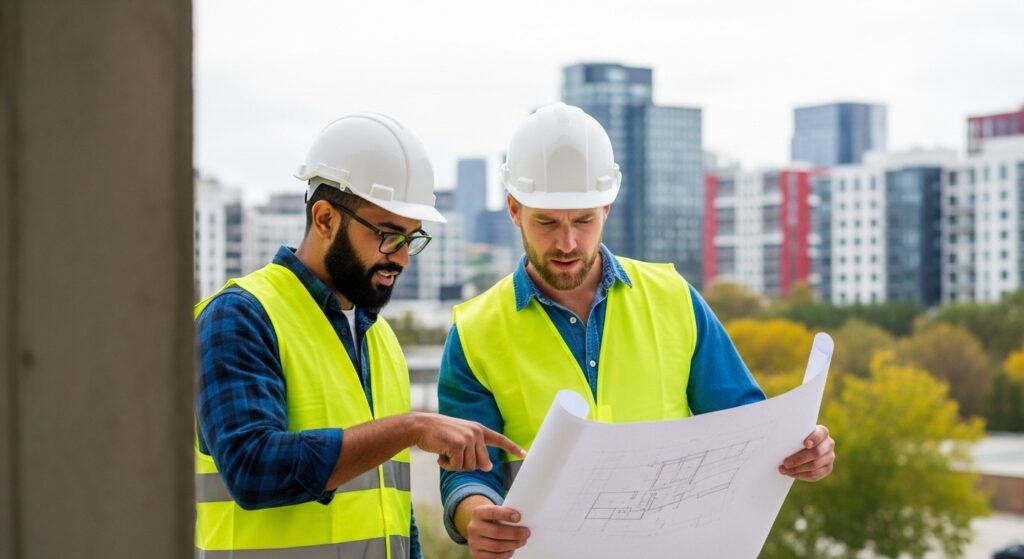In the construction world, blueprints, also known as plans or drawings, are essential documents that guide the building process. But does a builder truly build directly from a blueprint? Or is there more to the story when it comes to how construction projects come to life? In this article, we will explore the role of blueprints in the construction process, how builders work with them, and the various factors that influence the building process.
For those working with newcastle builder professionals or anyone interested in the construction field, understanding the relationship between builders and blueprints is crucial in ensuring that a construction project progresses smoothly and stays within budget.
What is a Blueprint?
Before delving into the role of a blueprint in the construction process, let’s define what it actually is. A blueprint is a detailed technical drawing of a building or structure, designed to outline how the structure will be built. Blueprints include a variety of information, such as:
- Dimensions: Measurements for walls, doors, windows, and other essential components of the building.
- Materials: The type of materials to be used, including types of wood, steel, or concrete.
- Structural Details: Specifications regarding foundations, beams, and other load-bearing elements.
- Electrical and Plumbing Layouts: Detailed plans for where electrical wiring, plumbing pipes, and HVAC systems will be installed.
Blueprints act as the roadmap for a construction project, offering builders a clear set of instructions for what needs to be done.
The Role of a Builder in Construction
A builder is a professional responsible for the physical construction of buildings, homes, and other structures. Builders take the plans provided by architects or designers and bring them to life. They manage the construction site, oversee workers, and ensure the project is progressing according to the design, timeline, and budget.
Builders Work with Plans, Not Just Blueprints
Although blueprints are essential to the process, builders don’t work exclusively from these plans. While blueprints provide the primary technical information, builders also rely on additional documents, specifications, and guidance to ensure that the project is executed correctly. These documents may include structural engineering reports, site plans, and other resources that outline specific construction techniques and methods.
In fact, many Newcastle builder professionals also use digital tools and software, such as Building Information Modeling (BIM), to get a more interactive view of the project. This allows them to visualize the construction process in 3D and make any necessary adjustments before actual work begins.
The Importance of Blueprints in Construction
Blueprints play a pivotal role in construction by providing a visual and technical guide for builders to follow. They ensure that the structure is built according to the design specifications, keeping the project on track in terms of safety, functionality, and aesthetics. Here’s why blueprints are so important:
1. Detailed Instructions
A well-constructed blueprint provides detailed instructions on every aspect of the project. Builders are able to interpret these instructions to determine how the structure should be built, from the foundations to the roof. The plans include the measurements and materials, leaving little room for confusion.
2. Ensures Compliance with Codes and Regulations
Building codes and regulations vary by location, and blueprints help ensure that the structure adheres to the necessary codes. These regulations govern the safety, design, and construction practices that must be followed. A builder relies on these plans to make sure the project complies with legal requirements, which can vary across regions, such as Newcastle builder projects, which must meet local standards.
3. Coordination of Trades
A blueprint also helps coordinate the various trades involved in the construction process. From electricians and plumbers to carpenters and roofers, every professional needs to know the exact placement of utilities, walls, and other key elements. By using blueprints, the builder can direct each trade to the appropriate areas of the construction site.
How Builders Use Blueprints During Construction
While blueprints provide critical information, builders often modify the plans slightly during the construction process to account for on-site conditions. Here’s how they typically use blueprints:
1. Site Preparation and Foundation
Before starting the physical construction of the structure, the builder uses the blueprint to mark out the foundation’s dimensions and placement. This includes marking the exact location of walls, windows, doors, and other structural elements. The builder may also need to adjust the plans based on factors like soil conditions or other site-specific challenges.
2. Framing and Structure
Once the foundation is in place, the builder will begin constructing the frame. Using the blueprint, the builder places beams, columns, and walls according to the specified dimensions. If changes to the original design are necessary, the builder will adjust the structure while still adhering to the general specifications.
3. Plumbing, Electrical, and Other Systems
Plumbing, electrical wiring, and HVAC systems must also be installed according to the plans provided in the blueprint. Builders will refer to these plans to make sure these systems are placed correctly and in compliance with safety codes. Any adjustments or unforeseen issues may require modifications to the original design.
4. Finishing Touches
Once the major structural work is complete, the builder will begin with the finishing touches, including installing flooring, windows, and doors. The blueprint guides the placement of these elements, ensuring that the design is followed closely.
Factors That Can Affect How Builders Work with Blueprints
While blueprints provide critical guidance, a number of factors can influence how closely a builder follows the original plan. These factors include:
1. Site-Specific Challenges
In some cases, site conditions might not be as expected. For instance, poor soil conditions might require additional foundation support, or unexpected weather may delay certain aspects of the construction. Builders must adapt to these challenges while still adhering to the general design provided in the blueprint.
2. Material Availability
Sometimes, the materials specified in the blueprint may not be available or may be prohibitively expensive. In these cases, the builder may need to source alternative materials that meet similar standards. This can require some modification to the blueprint, but the builder will ensure the structure remains strong and safe.
3. Design Changes
During construction, clients may request changes to the design. Builders are often asked to modify the layout or add new elements. These changes are typically incorporated into the project, but they require an updated set of blueprints and careful adjustments to ensure that the new plans fit within the existing framework.
4. Building Codes and Regulations
As mentioned earlier, building codes can vary by location. If local building codes change during the construction process, the builder must adjust the plans accordingly to ensure compliance. This can involve revising structural elements, electrical systems, or plumbing to meet updated regulations.
The Role of the Builder Beyond the Blueprint
While blueprints provide essential guidance, a builder’s role goes beyond simply following instructions. Here’s a look at some additional responsibilities:
1. Project Management
Builders are responsible for managing the entire construction project, ensuring that it stays on schedule and within budget. They coordinate with suppliers, subcontractors, and other trades, ensuring that materials and labor are available when needed.
2. Problem-Solving and Decision Making
As challenges arise, builders are expected to solve problems and make decisions that keep the project moving forward. Whether it’s adjusting the design due to unexpected issues or finding solutions to construction obstacles, builders must be adaptable and resourceful.
3. Ensuring Quality and Safety
Builders are also responsible for overseeing the quality and safety of the construction process. They ensure that all work is completed to the highest standards and that all safety regulations are followed. This helps to minimize risks and ensure the structure is safe for future occupants.
Conclusion
In summary, while builders certainly rely heavily on blueprints as a starting point, the process of constructing a building is far more dynamic and flexible. Builders use blueprints as a detailed guide, but they also must adapt to site conditions, material availability, design changes, and regulatory requirements. Their role goes far beyond simply building according to plans; they are responsible for managing the entire project, solving problems, and ensuring the construction process runs smoothly.
For homeowners, property buyers, or anyone working with a Newcastle builder, understanding the importance of blueprints and how builders work with them is essential. Blueprints provide the foundational instructions for a construction project, but builders use their expertise to bring the project to life while navigating the challenges that arise along the way. Whether you’re building a new home or renovating an existing property, ensuring that your builder has the experience and knowledge to work effectively with blueprints is crucial for a successful outcome.






